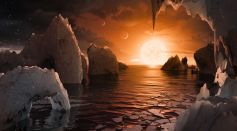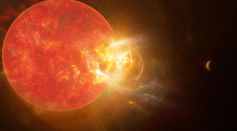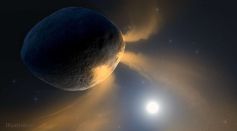Tags: Sun

Massive Solar Flare Directly Hitting Earth Today: NOAA Issues Geomagnetic Storm Watch
How Did the Planets of Solar System Align on the Same Plane? Orbit Line-Up Explained 4.5 Billions of Years Ago
Planets, Sun, Moon, Asteroids Orbiting on the Same Plane; Reason for Such, Explored From 4.5 Billion Years Ago
NASA’s Hubble Space Telescope Captures a Closer Look at AG Carinae; Giant Star’s Dual Nature Revealed in Stunning Images
Solar Flare Effects: What Is the Impact of Geomagnetic Storms on Earth's Field?
Sun After Its Death: Scientists Predict How, When It’s Going to Happen; What Will the Solar System Look Like Then?

Planet Nine Lurking Near Sun’s Orbit? Scientists Spot Planet Around Solar System
Stars Gobble Up Planets; Instability of Solar Systems Could Help Identify Sun-Like Stars Hosting Earth-like Planets
Human Mars Mission Safest Only When Less Than 4 Years at Solar Maximum

Solar Flare From Sun Might Be Heading to Earth; Should We Worry?

Will This Fastest Orbiting 0.6-Mile Wide Asteroid Found in Solar System Reach Earth?
Solar Radiation Greatly Affects Small Moon Iron Nanoparticles; Here Is What It Means
Morning Star Greets Earth With Love: When to Spot Venus in 2021
Comet Atlas Helps NASA Trace Back to Stone Age When Ancient Egyptians First Saw It 5,000 Years Ago
NASA's Black Brant IX Rocket to Solve Source of Sun's Hot Atmosphere Soon!

Asteroid 3200 Phaethon Has a Comet-Like Tail That Fizzes Near the Sun, Here's Why
Venus Flyby: ESA's Solar Orbiter Visits Earth's Hottest Neighbor for the Second Time But Fails to Capture Images of the Planet
Solar Storms Mystery Finally Solved: Simulation Model to Predict Space Weather, Geomagnetic Storms Developed

Nearby Star Resembles Young Version of Sun; Could Shed Light on How Life Began on Earth
Coronal Mass Ejection Caught on NASA Video Dispersing Billions of Hypersonic Particles, Watch Now!
Most Popular

Microplastics Are Everywhere — How Plastic Pollution Threatens Wildlife, Soil, and Water

Brain Health Aging Guide: Effective Strategies for Cognitive Decline Prevention and Lower Dementia Risk

Mitochondrial Health and Aging: How Cell Energy Drives Modern Anti-Aging Science

How Scientists Use Radio Telescopes to Search for Alien Signals Across the Universe




